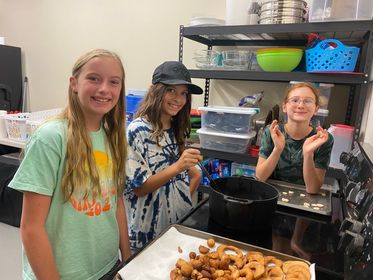We are so excited to have Kaley Martin with The Steadfast Project joining us to give her insight on getting your kids in the kitchen! The Steadfast Project offers leadership development and life skill classes, camps, and retreats for school aged kids. They have cooking classes for homeschoolers starting in September and they’re carrying throughout the fall!

My very first experience teaching cooking to children was 13 years ago. I was in the process of applying for a camp counselor position and had just requested the position of Cooking Activity Head. I was told that this was one of their least popular activities and that I would probably only have one or two classes compared to the five classes other popular activities might have. Fast forward to that summer and I was determined to make cooking cool again. The first day of camp involved signing up for activities and I was in hardcore marketing mode. I spent the day convincing every camper who would listen to me that in order to have the best summer ever they just had to sign up for my cooking class. I really don’t know if it was the idea of learning how to cook that excited them or if they just felt sorry for me, but I ended up maxing out those two classes and had to add three more. The next summer, another cooking activity head was hired, and the amount of classes available doubled.
Since that summer I have taught cooking at three different summer camps, offered online courses, and now teach here locally in Oxford, AL with my co-instructor Jessica Aycock. I say all that not to say that I’m a good cook. But I have a lot of experience convincing kids that cooking is not only fun, but a valuable life skill that everyone should have!
These days I don’t really have a hard time convincing most kids that cooking is exciting, but I’ve learned a lot of tips for introducing the skill of cooking to all ages. Here are a few:
- Invest in time: As a cooking instructor I know that the “time required” on a recipe does not match the time you’ll need when you are teaching little ones. But to be honest, I am not a mom so I asked Jessica what this looked like in her home. “You have to keep your vision realistic and be prepared to be patient with messes and inefficiencies” she said.
Typically, if a recipe suggests 20 minutes of prep time, I am prepared to double it (you should also be prepared to double the size of the mess and clean up time)! It’s no secret that patience will be your biggest asset in introducing this skill. I know that you could do it faster and have dinner on the table sooner if you did it yourself, but remind yourself of the investment you are making. While you may be able to crack half a dozen eggs in half a minute, including your child means that half the eggs are going to end up on the floor and you are going to spend five minutes fishing the egg shells out of your bowl. However, fast forward a month and now you are able to make omelets for your family in half the time because you have an egg cracking pro scrambling the eggs while you prep the veggies.
So invest now. Start dinner an hour earlier and leave extra time for clean up. As you add each new skill to your child’s repertoire, they will slowly become your sous-chef. That extra time now will lead to faster dinners in the future. Not only that, but it will also lead to a large collection of memories shared.
- Invest in tools: You have to meet children where they are. So many things about cooking are simply not kid-friendly. The height of the counter top, the size of the garlic press, and the sharpness of the knife. Focus on ways you can make it more obtainable for your child’s age. Stools or montessori learning towers are fantastic, but you can also place their task on the kitchen table for easier reach. Pulling down the required ingredients to their reach will also help with their independence in their tasks. You can also go the extra mile and order a number of kid-friendly kitchen gadgets. While these are not essential, they can help with mastering certain tasks. Personally, my go-to is a set of kid-friendly knives. These do a lot to increase your child’s skill and independence, while decreasing parents’ anxiety. Just be sure to instill the behavior of treating all knives like real knives so that the skills can be easily transferred when they are ready for the real thing.
- Invest in your family’s future: How many college freshmen are going to call home this month asking their parents “Hey mom/dad, how do you…”. What better way can we set them up for success than teaching them how to nourish their bodies? It’s never too late or too early! So whether your child is two or twenty-two, take the time now to set them up for their future.
And maybe you are the mom who feels like you don’t have much to teach. I promise that you do. Teach them how to be a good learner. Grow with them. In my cooking class, we always say that “there are no mistakes in cooking, only learning opportunities”. Sometimes those lessons are that salt and sugar look really similar and maybe that one step in the recipe that we skipped was actually important. Teach them to laugh at themselves and be lifelong learners.
Jessica told me that her kids often surprise her and prove themselves capable of doing more than anticipated when they are allowed to try. Investing this time in her kids has helped them develop an ability to follow directions, better hand-eye coordination, increased self-esteem, and a sense of value as they meet a need for their family. Here’s her encouragement to parents: “Your kids will be much more likely to be excited about joining you in the kitchen if you express interest and excitement in the kitchen. For me, cooking is an extension of myself where I use my time, skills, and knowledge to nourish my family’s bodies and souls. One of my highest pleasures is making something good to eat and sharing it with people who enjoy it. By teaching my children to cook, I hope to enable them to experience this pleasure as well and make some fun memories in the process!”
Kaley Martin
Owner of The Steadfast Project
Thesteadfastproject.com








